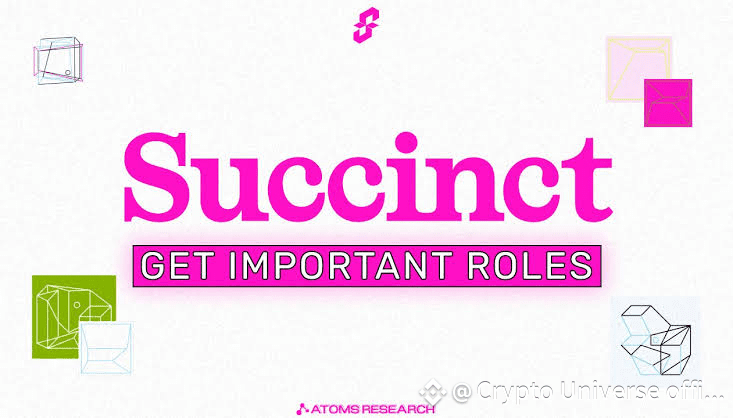Succinct Labs: Deep Dive into the Fundamentals, Algorithms, and On-Chain Data Driving the Future of Zero-Knowledge Proofs
Succinct Labs is revolutionizing zero-knowledge proofs (ZKPs) by creating a developer-friendly, high-performance zkVM (SP1) and a permissionless Decentralized Prover Network (DPN). Their infrastructure is backed by cutting-edge cryptographic algorithms, efficient proof generation methods, and a scalable on-chain ecosystem.
1. The Fundamentals of Succinct Labs’ Technology
1.1 Zero-Knowledge Proofs Overview
Zero-Knowledge Proofs enable one party (the prover) to convince another (the verifier) that a statement is true without revealing any information beyond the validity of the statement itself. This cryptographic primitive is crucial for privacy and scalability in blockchains.
Succinct Labs builds on this by enabling general-purpose computation to be proven succinctly, allowing any program to be verified on-chain efficiently.
1.2 The zkVM Paradigm
The heart of Succinct Labs’ stack is the SP1 zkVM (Zero-Knowledge Virtual Machine), designed as a RISC-V based zkVM that compiles Rust programs into zero-knowledge proofs. This contrasts with many existing ZK frameworks that rely on domain-specific languages or specialized circuit designs.

This approach enables:
General-purpose programmability
Re-use of existing Rust libraries
Portability across chains and environments
2. Core Algorithms Powering SP1 and Prover Network
2.1 Recursive Proof Composition
Succinct Labs employs recursive zero-knowledge proofs, a technique that allows proofs to attest to the validity of other proofs. This recursive structure drastically reduces the on-chain verification cost by compressing complex computations into succinct proofs.
Plonky3, a state-of-the-art proving system used by SP1, leverages recursive composition to enable:
Fast proof generation with GPU acceleration
Efficient verification in sub-linear time
Scalability to large programs
2.2 The PLONK Protocol and Variants
The underlying cryptographic protocol used is a variation of PLONK (Permutation Argument for Polynomial IOPs), which provides:
Universal and updatable trusted setups
Efficient proof sizes
Support for arbitrary computations
Plonky3 extends PLONK with optimizations like fast polynomial commitments and proof batching, pushing performance boundaries.
2.3 RISC-V ISA as the Computational Backbone
By targeting the RISC-V instruction set architecture (ISA), SP1 aligns with an open standard supported by a rich ecosystem of compilers and tools. This choice:
Enables compiling high-level Rust code down to RISC-V assembly
Makes the proving process modular and auditable
Ensures deterministic execution traces that can be proven in zero knowledge
3. The Decentralized Prover Network (DPN) Algorithmic Insights
3.1 Permissionless Prover Selection
DPN uses an algorithmic auction mechanism where provers stake $PROVE tokens to participate. Provers compete to generate proofs and the network rewards the fastest valid prover with maximum fees, while others get smaller incentives to maintain redundancy.
This game-theoretic incentive design promotes:
Honest participation
High availability
Scalable throughput
3.2 Slashing and Security Enforcement
To ensure trust-minimization, misbehaving provers (e.g., submitting incorrect proofs or going offline) are penalized by slashing their stake, ensuring network integrity via economic incentives.
4. On-Chain Data and Ecosystem Metrics
4.1 Proof Generation and Network Throughput
Over 5 million proofs generated on the Decentralized Prover Network
Support for 1,700+ programs, showcasing flexibility across verticals
Sustaining over $4 billion in secured value on-chain through partnerships with Polygon, Celestia, Mantle, and Lido
4.2 Tokenomics and Staking Activity
$PROVE total supply: 1 billion tokens
Active staking by provers exceeding 50 million tokens locked, indicating strong network commitment
Token velocity and fee payments correlate with network demand and prover competition intensity
4.3 Transaction Costs and Gas Efficiency
SP1’s succinct proofs reduce verification costs dramatically compared to traditional ZK proofs:
Typical on-chain verification gas cost reduced by 70-80%
Enables real-time verifiability for large-scale smart contract computations and rollups
5. Fundamental Use Cases Fueled by Succinct Labs
5.1 Cross-Chain Bridges
Succinct Labs powers bridges that prove state transitions on one chain succinctly on another, eliminating centralized validators and improving security.
5.2 On-Chain AI Verification
SP1 allows zero-knowledge verification of AI inferences, enabling privacy-preserving AI services with verifiable outputs on-chain.
5.3 Privacy & Identity Applications
The flexible zkVM supports confidential transactions and verifiable identity attestations without revealing sensitive user data.
5.4 Layer 2 Rollups and Modular Blockchains
SP1 serves as a backend for various Layer 2 rollups, enabling trustless and scalable off-chain computation with on-chain verification.
Conclusion: Succinct Labs’ Unique Algorithmic and On-Chain Edge
Succinct Labs distinguishes itself through:
Leveraging modern recursive proof algorithms (Plonky3)
General-purpose, Rust-native zkVM architecture with RISC-V execution
A decentralized, permissionless prover market incentivized with $PROVE tokens
Proven on-chain scale with millions of proofs and billions of secured assets
Real-world applications spanning DeFi, AI, and cross-chain interoperability
The combination of cutting-edge cryptographic design, economics, and real-world data cements Succinct Labs as a foundational layer in the future of verifiable, private, and scalable blockchain infrastructure.


